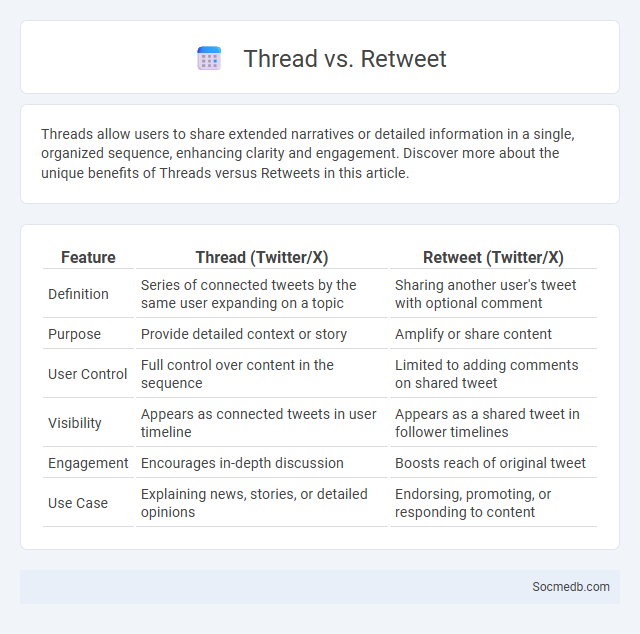
Photo illustration: Thread vs Retweet
Threads allow users to share extended narratives or detailed information in a single, organized sequence, enhancing clarity and engagement. Discover more about the unique benefits of Threads versus Retweets in this article.
Table of Comparison
| Feature | Thread (Twitter/X) | Retweet (Twitter/X) |
|---|---|---|
| Definition | Series of connected tweets by the same user expanding on a topic | Sharing another user's tweet with optional comment |
| Purpose | Provide detailed context or story | Amplify or share content |
| User Control | Full control over content in the sequence | Limited to adding comments on shared tweet |
| Visibility | Appears as connected tweets in user timeline | Appears as a shared tweet in follower timelines |
| Engagement | Encourages in-depth discussion | Boosts reach of original tweet |
| Use Case | Explaining news, stories, or detailed opinions | Endorsing, promoting, or responding to content |
Understanding Threads: Definition and Purpose
Threads on social media are sequences of connected posts or messages centered around a single topic, designed to facilitate organized and coherent conversations. These threads enable users to follow discussions effortlessly, enhancing engagement and information sharing within communities. By structuring content this way, platforms improve clarity and user interaction while supporting deeper exploration of subjects.
What is a Retweet? Core Function Explained
A retweet is a feature on Twitter that allows users to share someone else's tweet with their own followers, amplifying the original message's reach. This core function helps you spread content quickly, engage with trending topics, and participate in conversations without creating new posts. Retweeting preserves the original tweet's text, media, and author information, maintaining content authenticity while boosting visibility.
Key Differences: Thread vs Retweet
Threads allow you to create a series of connected posts to share detailed stories or information, enabling deeper engagement and narrative flow. Retweets, in contrast, enable quick sharing of another user's single post to amplify content without adding new commentary. Your choice between threads and retweets depends on whether you want to provide extended context or simply promote existing messages.
How Threads Enhance Storytelling
Threads enhance storytelling by allowing you to connect multiple posts into a coherent narrative, making complex ideas easier to follow. Each thread segment builds on the previous one, increasing engagement and providing deeper context that enriches the overall message. Effective use of threads can boost visibility and foster meaningful interactions on social media platforms.
Retweets for Amplification and Engagement
Retweets significantly boost your social media presence by increasing content visibility and driving engagement across platforms like Twitter. Leveraging retweets extends the reach of your messages to wider audiences, fostering community interaction and amplifying brand awareness. Optimizing content for retweet potential involves crafting compelling, shareable posts that resonate with your target audience.
Creating Impactful Twitter Threads
Creating impactful Twitter threads requires crafting concise, engaging content that delivers value to Your audience while maintaining clarity and flow across multiple tweets. Utilize compelling hooks, relevant hashtags, and clear call-to-actions to maximize reach and interaction. Strategic use of visuals and data enhances message retention and fosters stronger engagement on social media platforms.
Advantages and Disadvantages of Retweeting
Retweeting on social media amplifies message reach, increases engagement, and helps build community trust by sharing valuable content quickly. However, it also carries risks such as spreading misinformation, diluting original context, and potentially damaging personal or brand reputation. Careful consideration is essential to leverage retweeting benefits while minimizing negative impacts on audience perception.
When to Use Threads vs Retweets
Threads on social media are ideal for sharing detailed narratives or step-by-step information, allowing users to engage deeply with extended content in one continuous format. Retweets work best for amplifying concise messages or noteworthy updates, facilitating rapid dissemination to broader audiences. Choosing between threads and retweets depends on whether the goal is comprehensive storytelling or quick content sharing across the network.
Best Practices for Maximizing Visibility
Maximizing visibility on social media requires consistent posting tailored to your target audience's peak activity times. Engaging content, such as interactive polls and high-quality visuals, drives higher interaction rates and boosts algorithmic favor. You should also leverage relevant hashtags and collaborate with influencers to widen your reach and attract diverse followers.
Choosing the Right Strategy for Your Twitter Content
Selecting the right strategy for your Twitter content requires analyzing your target audience's preferences and engagement patterns to maximize reach and interaction. Tailoring tweets with a mix of informative, entertaining, and promotional content ensures sustained follower interest and brand visibility. You should consistently monitor analytics to refine your approach based on performance metrics such as likes, retweets, and click-through rates.
 socmedb.com
socmedb.com